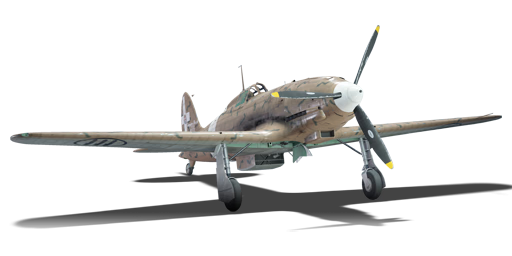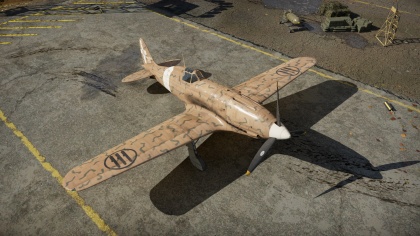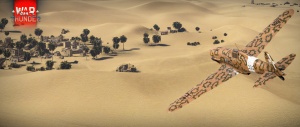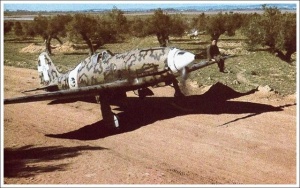C. 202 (Germany)
Contents
| This page is about the fighter C. 202 (Germany). For other uses, see C.202 (Family). |
Description
The ▀C. 202 Folgore is a rank I German fighter
with a battle rating of 3.0 (AB/RB) and 2.3 (SB). This fighter has been in the game since the start of the Open Beta Test prior to Update 1.27. In Update 1.69 "Regia Aeronautica", the C.202 as well as the other Italian planes in the German tree were moved to the new Italian tree, although it still exists in the German tree for those who unlocked it prior to Update 1.69.
The Folgore is an Italian fighter that is best suited to attack other fighters. It's unsuited as a fighter bomber due not being able to carry bombs or rockets.
The advantages of the Folgore are the combination of good speed, very good rate of climb and roll rate. Furthermore it's fairly sturdy, it can take a few hits and get back to base without much problems. The Folgore is a fairly speedy turner, preferring to turn at high speeds, however flat out turning is still a bad idea, unless you abuse the rate of roll to get into an advantageous position.
The second major issue the Folgore has, is that the damage output is low. It needs quite extended bursts of fire to deal decent amounts of damage. Furthermore, the Breda SAFAT's damage potential drops off when it's fired at ranges above 300 meters. The poor armament also makes it less then optimal at engaging bombers and heavy fighters. The consensus by the community is that the best belts are anti-air, tracer or stealth for the 12.7 mm's and stealth and omni for the 7.7's. These seem to do the most damage.
While neither of these are crippling, they are something to keep in mind, especially since the Folgore doesn't allow for many mistakes.
General info
Flight Performance
Describe how the aircraft behaves in the air. Speed, manoeuvrability, acceleration and allowable loads - these are the most important characteristics of the vehicle.
| Characteristics | |||||||
|---|---|---|---|---|---|---|---|
| Stock | |||||||
| Max Speed (km/h at 6,000 m) |
Max altitude (meters) |
Turn time (seconds) |
Rate of climb (meters/second) |
Take-off run (meters) | |||
| AB | RB | AB | RB | AB | RB | ||
| 576 | 560 | 10200 | 22.5 | 23.2 | 22.5 | 22.5 | 368 |
| Upgraded | |||||||
| Max Speed (km/h at 6,000 m) |
Max altitude (meters) |
Turn time (seconds) |
Rate of climb (meters/second) |
Take-off run (meters) | |||
| AB | RB | AB | RB | AB | RB | ||
| 624 | 600 | 10200 | 20.4 | 21.4 | 29.5 | 25.6 | 368 |
Details
| Features | ||||
|---|---|---|---|---|
| Combat flaps | Take-off flaps | Landing flaps | Air brakes | Arrestor gear |
| ✓ | ✓ | ✓ | X | X |
| Limits | ||||
|---|---|---|---|---|
| Wing-break speed (km/h) |
Gear limit (km/h) |
Combat flaps (km/h) |
Max Static G | |
| + | - | |||
| 600 | ~15 | ~6 | ||
| Optimal velocities | |||
|---|---|---|---|
| Ailerons (km/h) |
Rudder (km/h) |
Elevators (km/h) |
Radiator (km/h) |
| < 400 | < 270 | < 550 | > 350 |
| Compressor (RB/SB) | ||
|---|---|---|
| Setting 1 | ||
| Optimal altitude | 100% Engine power | WEP Engine power |
| 4,500 m | 1,084 hp | 1,218 hp |
Survivability and armour
- 8 mm Steel - Behind pilot seat
- 50 mm Bulletproof glass - Windscreen
Armaments
Offensive armament
The C. 202 (Germany) is armed with:
- 2 x 12.7 mm Breda-SAFAT da 12.7 mm machine guns, nose-mounted (400 rpg = 800 total)
- 2 x 7.7 mm Breda-SAFAT da 7.7 mm machine guns, wing-mounted (500 rpg = 1,000 total)
Usage in battles
The most important things the Folgore needs are Speed and Altitude. It's generally a good idea to climb to at least 5000 - 6000 meters before levelling out and gaining speed. From there on, it's Boom and Zoom, working your way from top to bottom. Priority should be given to P-39 Airacobras, F6F Hellcats and the early Spitfire, as these are hard to beat if they are allowed to engage on their terms. The Hellcat is a considerable problem for the Folgore, due to the fact its considerably faster and climbs only slightly worse. The best way of dealing with them is to fight them at speeds above 400 km/h (250 mph), where the Hellcat begins to stiffen up, but you retain your very good roll rate, which you can use to spoil his gun solution by constantly changing direction.
While diving on your chosen target, be mindful of your speed, the Folgore's rate of roll becomes considerably worse when you hit 600 km/h (370 mph), so it's a good idea to cut throttle at the final part of your dive, slowing your acceleration down by a bit. Also, when trying to lead an enemy plane that is making a hard break turn, try to avoid making high G turns or turns that burn a lot of speed, this mostly happens when you dive in at a shallow angle, as it will inevitably force you to engage in a dogfight, where the turn rate offers an advantage to the enemy. While it is doable, it's generally better to run, by going into a shallow dive. Alternatively, engage in a shallow climb, the rate of climb is one of the best at its tier, meaning that if you have a small speed advantage you can get some separation and climb away.
The guns make it unsuited to effectively engage bombers, especially well defended bombers such as the B-25 and the A-20. It's better to team up with your teammates than to try to attack them on your own. Further it's best to aim for the engines and wings, basically engaging them the same way as you would engage fighters.
Furthermore, the Folgore cannot carry any bombs, so it's less effective in a ground attack role.
For belts use tracers, anti-air or stealth as they deal the most damage, with a good mix of incendiary and shrapnel. Breda-SAFAT's shell velocity is low, hence they suffer at ranges greater than 300 meters, so only fire at or below that range for best effects. Furthermore, the armament is woefully inadequate to deal with bombers. It is best to avoid them entirely, or focus on taking out the engines. The only exceptions are the very early biplane bombers, such as the Swordfish, Po-2 and the likes.
Manual Engine Control
| MEC elements | ||||||
|---|---|---|---|---|---|---|
| Mixer | Pitch | Radiator | Supercharger | Turbocharger | ||
| Oil | Water | Type | ||||
| Not controllable | Controllable Not auto controlled |
Controllable Not auto controlled |
Controllable Not auto controlled |
Separate | Not controllable 1 gear |
Not controllable |
Modules
| Tier | Flight performance | Survivability | Weaponry | |
|---|---|---|---|---|
| I | Fuselage repair | Radiator | Offensive 7 mm | |
| II | Compressor | Airframe | New 7 mm MGs | |
| III | Wings repair | Engine | Offensive 12 mm | |
| IV | Engine injection | Cover | New 12 mm MGs | |
The Folgore's focus on energy fighting should be reflected in the desired grind strategy. Compressor & Engine are the top priority, boosting the acceleration and climb to the maximum needed for most situations. The next upgrades are free to choose for you. New belts are always nice, but the default ones are decent.
Pros and cons
Pros:
- Good speed
- Good rate of roll under 600 km/h (370 mph)
- The best climb rate in its rank
- Decent performance on all altitudes, especially for a 1st rank plane
- Decent cockpit visibility, especially to the rear
- Decent energy retention in horizontal turns
Cons:
- Large turn radius, not as agile as its predecessor
- Firepower leaves things to be desired
- Thick canopy framing can make spotting hard from cockpit view
- Armament is weak. Will struggle to kill bombers and heavy fighters with structural damage alone
History
The famed Italian ace Maggiore Adriano Visconti flew the Folgore, including the predecessor Macchi C.200 Saetta and the successor Macchi C.205 Veltro.
In late 1941 the newer and deadlier Macchi MC.202 Folgore (Thunderbolt) began to equip units of 7° Gruppo, and in early 1942 Visconti began flying the sleek, new fighter on photo reconnaissance sorties over Malta. Throughout these early years of the war, a near constant trickle of supplies was required to keep the strategically vital island of Malta alive and in allied hands: mid-June 1942 saw two of these convoys simultaneously attempt to resupply the island from different directions. Operation Harpoon – a convoy from Gibraltar – was coordinated with Operation Vigorous from Alexandria. Both convoys were opposed by axis forces and on June 15th, in the air battle above Operation Harpoon which would become known as the Battle of Pantelleria, Visconti shot down a Bristol Blenheim. On August 13th, whilst on a two aircraft reconnaissance sortie, Visconti and his wingman were jumped by four RAF Spitfires. Visconti engaged and shot down two Spitfires, allowing the second M.C.202 to complete the sortie. He was awarded another Medaglie d’Argento for his skill and courage.
Visconti served in Greece before being promoted to Capitano and taking command of 76a Squadriglia as 54° Stormo was deployed in Tunisia in March 1943. In the brief weeks of fighting which led up to the axis surrender in May, Visconti was credited with two Spitfires and a P-40, as well as several other probable victories. Sharing a cramped cockpit with a fellow pilot, Visconti escaped the allied advance by flying to Sicily. Given his wealth of experience carrying out high speed, daylight reconnaissance flights over Malta, Visconti was given command of 310a Squadriglia Caccia Aerofotografica, a newly formed reconnaissance squadron equipped with modified Macchi C.205 Veltros (Greyhounds) which were based east of Rome.[1]
Visconti remains a controversial figure due to his political alignment with Mussolini's Italian Social Republic.
In-game description
"The Macchi M.C.202 was an Italian all-metal fighter interceptor, initially armed with nothing but twin synchronised 12.7mm (.50-cal) machine guns in the engine housing. The woefully ineffective armament for a fighter that plagued many other Italian fighters was finally remedied on the M.C.202 Serie VI (variants of the aircraft were designated with Roman numerals, I through XI), when two additional 7.7mm machine guns were added to the wings.
The Folgore (Lightning), as the new fighter was called, was aerodynamically clean and well-balanced. Its sturdy construction used modern flush riveting on all surfaces, and special care was taken in design and production to streamline all joints. The engine cover had a clean aerodynamic profile, which formed a smooth line from the propeller hub, through the canopy, and back into the empennage."
Media
Excellent additions to the article would be video guides, screenshots from the game, and photos.
References
- ↑ An excerpt from Ace of the Month - January - Maggiore Adriano Visconti, written by Mark Barber, War Thunder Historical Consultant alias Wafu Vasco.
See also
Links to the articles on the War Thunder Wiki that you think will be useful for the reader, for example:
- reference to the series of the aircraft;
- links to approximate analogues of other nations and research trees.
External links
- [Profile] Ace of the Month - January - Maggiore Adriano Visconti from the War Thunder official forum.
| Germany fighters | |
|---|---|
| Heinkel | |
| He 51 | He 51 A-1 · He 51 B-1 · He 51 B-2/H · He 51 C-1 · He 51 C-1/L |
| He 100 | He 100 D-1 |
| He 112 | He 112 A-0 · He 112 B-0 · He 112 B-1/U2 · He 112 B-2/U2 · He 112 V-5 |
| Messerschmitt | |
| Bf 109 (Jumo) | Flegel's Bf 109 A · Bf 109 B-1 · Bf 109 C-1 · Bf 109 C-1 |
| Bf 109 (DB-601) | Bf 109 E-1 · Bf 109 E-3 · Bf 109 E-4 · Bf 109 E-7/U2 · Bf 109 F-1 · Bf 109 F-2 · Bf 109 F-4 · Bf 109 F-4/trop |
| Bf 109 (DB-605) | Bf 109 G-2/trop · Bf 109 G-2 · Bf 109 G-6 · Bf 109 G-10 · Bf 109 G-14 · Bf 109 K-4 |
| Focke-Wulf | |
| Fw 190 (early) | Fw 190 A-1 · Fw 190 A-4 · Fw 190 A-5 · Fw 190 A-5 · Fw 190 A-5/U2 · Fw 190 A-5/U14 · Fw 190 A-8 · Fw 190 C |
| Fw 190 (late) | Fw 190 D-9 · Fw 190 D-12 · Fw 190 D-13 |
| Ta 152 | Ta 152 C-3 · Ta 152 H-1 |
| Blohm & Voss | |
| BV 155 | BV 155 B-1 |
| Captured: | |
| USA | ▀P-47D-16-RE · ▀P-47D |
| USSR | ▀La-5FN · ▀Yak-1B |
| Britain | ▀Tempest Mk V |
| Italy | |
| CR.42 | ▀CR.42 · ▀Marcolin's C.R.42 CN |
| G.50 | ▀G.50 serie 2 · ▀G.50 AS serie 7 |
| C.200 | ▀C. 200 serie 3 · ▀C. 200 serie 7 |
| C.202 | ▀C. 202 |
| Finland | ▀Hawk H-75A-2 |







